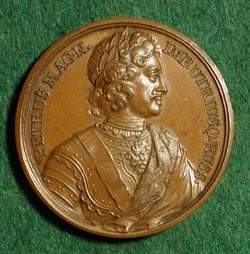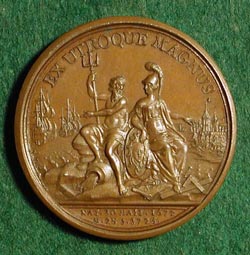

|
DEATH OF PETER THE GREAT OF RUSSIA DASSIER, Jean: Russia, 1725, Bronze, 38 mm Peter I (the Great) (1672-1725), Russian czar (1682-1721) and emperor (1721-1725) was the son of Alexei Michailovich. Peter inherited a landlocked nation and gaining access to the sea became the chief objective of his foreign policy. This led to his being engaged in the Russo-Turkish Wars and in the major conflict of his reign, the Great Northern War (1700-1721) with Sweden. In this latter war Peter gained access to the Baltic Sea by defeating Charles XII of Sweden in the Battle of Poltava (1709) (see chapter on Russia). He also conquered the mouth of the Neva River on the Gulf of Finland, where he founded the great city of St. Petersburg, to which this medal alludes. At home, Peter launched a rapid modernization of Russia, based on knowledge acquired of new industrial methods in Western Europe during his so-called "Grand Embassy" tour. He developed metallurgical and manufacturing industries in order to build a modern army and a powerful Baltic fleet. These industries mainly used serf labor, and Peter brutally suppressed serf revolts. Peter broke the power of the Boyars (landed aristocracy) by abolishing the Boyar council as the supreme central organization, replacing it with a senate. He also created a meritocratic system of appointment, ending the rule of promotion according to ancestry. Peter placed the Russian Orthodox Church under state control and sold off much church land. He also encouraged secular education and introduced a new calendar. He was succeeded by his wife, Catherine I. (From O'Brien) This medal commemorates the death of Czar Peter I in 1725. The reverse of the medal shows Neptune and Minerva, representing the rise in sea power and magnificence of the building of St. Petersburg during his reign. |
|